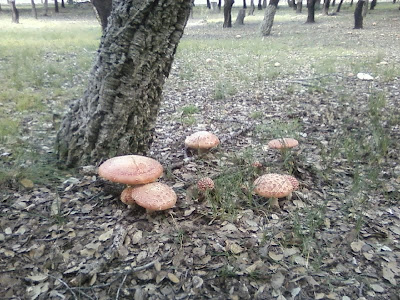The plantation was initially established with acorns that Walter Burley Griffin, landscape architect and designer of Canberra had imported from Spain in 1917. Walter Burley Griffin (1876-1937)(bio here) had a vision for the new city of Canberra to be self sustainable and a cork plantation was included in his original plan for Canberra. The plantation was established by Thomas Weston (1866-1935)(bio here).
The plantation is comprised of nearly 4,500 90 year old trees established on 8 hectares (20 acres). It is the largest mature commercial plantation of cork oak in the Southern Hemisphere. Cork oak is a species native to Southern Europe and has been harvested for centuries. The harvest, which involves the delicate stripping of the cork trees' outer bark can initially be carried out when the tree is about 25 years old and requires 3 'cycles' of harvesting (one cycle every 10 years) before it produces cork of a high quality.
The plantation was left untouched until 1948 when harvesting or 'stripping' was commenced and the cork was found to be of both high quality and commercially valuable. In 1981 the plantation was harvested by ACT Forests by professional cork strippers from Portugal and again in 2001 when two Portuguese 'cork strippers' - Manuel Silva and Manuel Graça helped harvest the plantation.
A cork oak can live for 500 years and grow to 20 meters tall. Apparently the 'stripping' of cork bark is important for the on-going vitality of the tree and increases the amount and quality of the cork for future harvests. Cork oaks fruit every 2-3 years producing large quantities of acorns. The cork oak plantation could produce between 600,000 and 750,000 corks every nine years. It is estimated that the cork from these trees will be mature enough for use in wine bottles in 15-20 years.
The plantation is on several heritage registers as a historic site.

The entrance.

A view from within the plantation.

'Stripped' trees.

All shapes, all sizes.

Amanita muscaria mushrooms (here) are everywhere...
DO NOT EAT!
Access from the new Black Mountain car park. Near the Aranda frost hollow Snowgums...
--------------------------------------------------------
UPDATE: 6/8/12 A continuation to this post
--------------------------------------------------------
View Larger Map








No comments:
Post a Comment